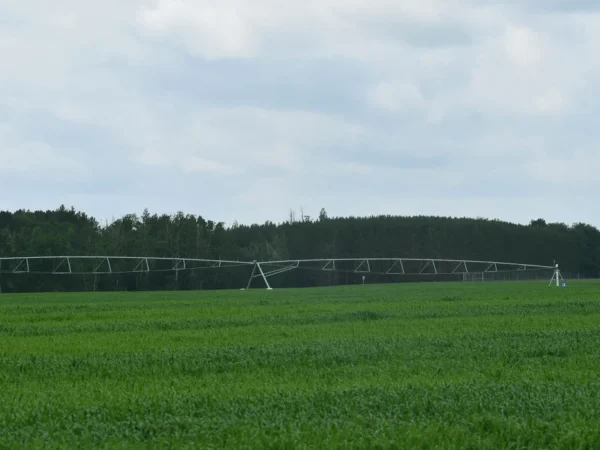
A decades-long monitoring project in the Great Lakes basin has started checking for PFAS in rain. It’s finding the forever chemicals across the basin in large amounts.
Those numbers aren’t published yet, but PFAS are showing up in concentrations higher than legacy contaminants like mercury, PCBs (polychlorinated biphenyls) and pesticides.
“When we compare these chemicals to the legacy compounds—PCBs and pesticides—we see that they are one or two orders of magnitude bigger in the same samples,” said Marta Venier, a professor at the Paul H. O’Neill School of Public and Environmental Affairs at Indiana University.
One order of magnitude is the difference between 10 and 100. Two orders of magnitude is the difference between 10 and 1000.
An addition to an old program
While monitoring for PFAS in rain is new for the Integrated Atmospheric Deposition Network, which Venier leads, monitoring contaminants in precipitation, called atmospheric deposition, has been going on since 1994. The program adapts to track problem chemicals as they come to the network’s attention as apparently harmful.
In 2005, the program started tracking flame retardants and, just recently, they added PFAS.
They collect air samples every 12 days and precipitation samples every month, though PFAS is only tested in precipitation samples because PFAS travels in water better than the other monitored chemicals.
Since the program’s start, it has recorded steady declines of many legacy chemicals.
In Cleveland, PCBs in precipitation have trended downward, taking about 9 years to reduce by half. PCBs were manufactured in the U.S. until 1979 and have been linked to cancer, reduced immune response and endocrine system disruptions.
In Eagle Harbor, Michigan, on Lake Superior, DDT (which had its use drastically reduced in in 1972) and Chlordane (a pesticide banned in 1988) have reduced by half about every 8 years.
While they haven’t published the specific concentrations of PFAS collected, differences between rural and urban stations are starting to become clear.
“Generally, our most urban sites—our Chicago and Cleveland sites—have the highest concentrations of PFAS, and our rural and remote sites have lower concentrations,” said Abby DeMeyer, a graduate student at Indiana University who works on the project.
“In general, that’s what we expect,” Venier said. “For most of the compounds we have seen a very good correlation between population and the atmospheric levels.”
But the sites farther from urban centers turned up a higher proportion of the more volatile neutral PFAS, DeMeyer said.
This suggests neutral PFAS are moving out from cities to more remote places.
The PFAS compounds that have been garnering news coverage and the attention of state and national regulation are ionic PFAS. Neutral PFAS are less studied, in part because tools to do so weren’t available until more recently.
“It clearly indicates that it’s an environmental concern that we should be paying attention to,” Venier said.
These findings don’t mean that the rain is directly dangerous.
“If you wear GORE-TEX while you’re out and you get rained on, that’s more dangerous than the rain,” Venier said.
PFAS movements and important piece to the puzzle
Atmospheric deposition, the process by which contaminants move through the atmosphere from one place to another, is an important pathway for PFAS contamination.
“How they’re moving around is an important piece of the puzzle,” said Tom Bruton, senior scientist at the Green Science Policy Institute, an organization that works to reduce PFAS use. “And it really is a puzzle, because we don’t always know where they’re coming from.”
A 2015 Center for Disease Control and Prevention report found that 97% of Americans have PFAS in their blood.
But that many people don’t live downstream of dump sites, Bruton said.
“Atmospheric deposition is one way of getting at this question of how do PFAS get to the places where there is a public health concern,” Bruton said.
Research in Vermont and New York showed PFAS emissions from a factory traveled 8 kilometers (about 5 miles) through the air to contaminate groundwater. The contaminated groundwater was 300 meters (about 1000 feet) higher in elevation than the factory, making air transport the likely source of contamination. Researchers found PFOA levels of 100 parts per trillion, higher than the EPA’s limit of 70 parts per trillion for drinking water and much higher than the standards many states are setting.
PFAS pollution of soil and water from atmospheric deposition has been documented from factories in West Virginia and North Carolina.
Atmospheric transport has sent PFAS to the top of Mt. Everest and the top of the world in the Arctic Ocean.
The Integrated Atmospheric Deposition Network is tracking 52 PFAS compounds.
“We’re proud that we measure so many of these chemicals,” Venier said. “But we measure nothing compared to what’s out there.
“That’s probably only the tip of the iceberg,” she said.
Catch up on more PFAS news on Great Lakes Now:
PFAS is in fish and wildlife. Researchers prowl Michigan for clues.
PFAS in the House: Are toxic “forever chemicals” a steady drip in this reporter’s home?
API key not valid. Please pass a valid API key.Featured image: Rain on window (Photo Credit: Natasha Blakely)




